Page 125 of 402
Downloaded from www.Manualslib.com manuals search engine A. Air Vents
B. Instrument Cluster
C. Electronic Transfer Case
(If Equipped)
D. Comfort Controls
E. Glove Box
F. Ashtray
G. Cigarette LightedPower Auxiliary
Outlets
(If Equipped)
H. Storage Compartment
I. Audio System
J. Fog Lamps (If Equipped)
K. Lamp Controls
L. Rear Endgate Release
M. Brake Release
N. Rear Window Washermiper
0. Rear Window Defogger (If Equipped)
2-68
Page 132 of 402
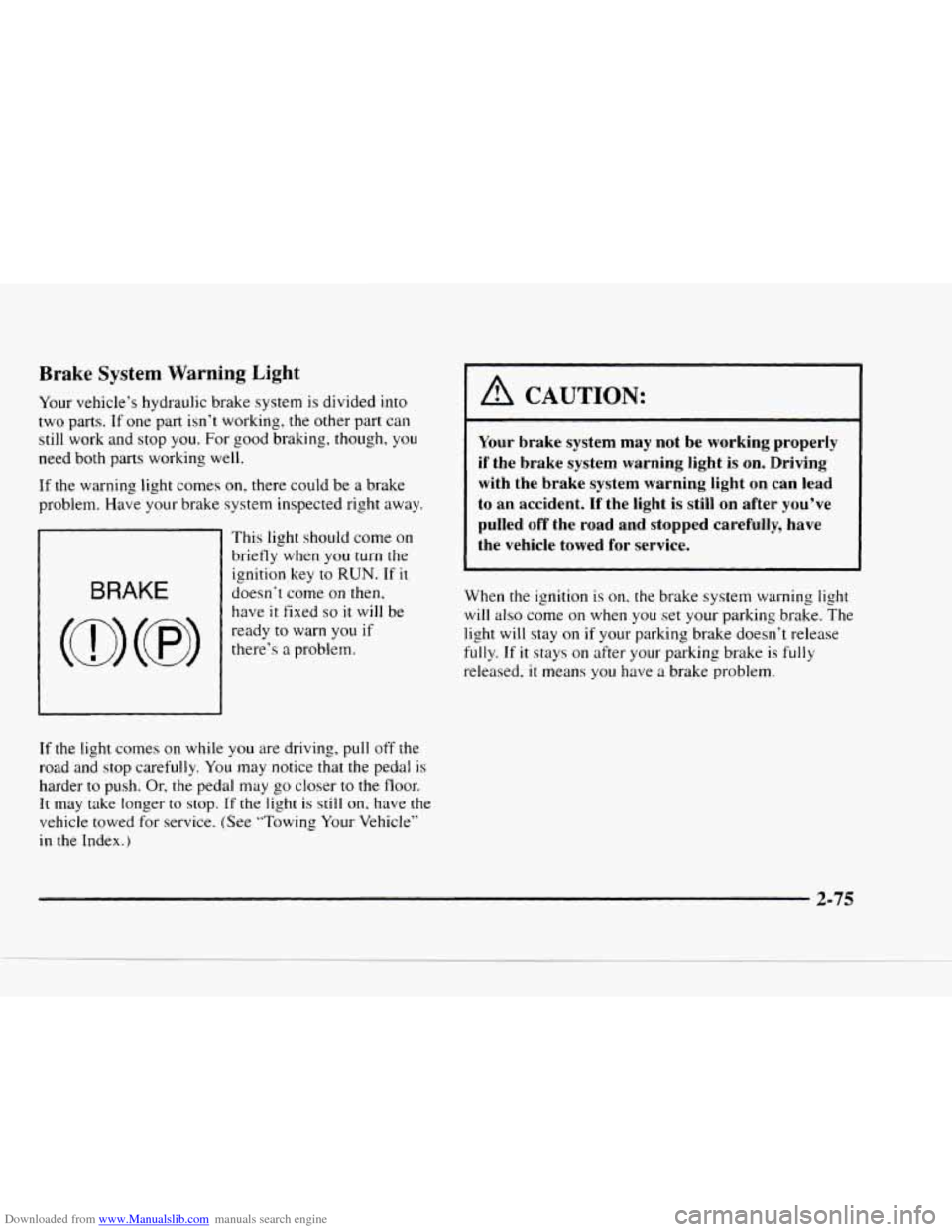
Downloaded from www.Manualslib.com manuals search engine Brake System Warning Light
Your vehicle’s hydraulic brake system is divided into
two parts.
If one part isn’t working, the other part can
still work and stop you. For good braking, though, you
need both parts working well.
If the warning light comes
on, there could be a brake
problem. Have your brake system inspected right away.
1
This light should come on
briefly when
you turn the
ignition key to RUN. If it
doesn‘t come on then, BRAKE
(a) (0)
:;2:0,;21:: if
have it fixed so it will be
If the light comes on
while you are driving, pull off the
road and stop carefully. You may notice that the pedal is
harder to push. Or, the pedal may go closer to the floor.
It may take longer to stop. if the light is still on, have the
vehicle towed for service. (See ”Towing Your Vehicle”
in the Index.)
I A CAUTION:
I 1
Your brake system may not be working properly
if the brake system warning light is on. Driving
~ with the brake system warning light on can lead
to an accident. If the light is still on after you’ve
pulled
off the road and stopped carefully, have
the vehicle towed for service.
When the ignition is on. the brake system warning light
will
also come on when you set your parking brake. The
light
will stay on if your parking brake doesn’t release
fully. If it stays on after your parking brake is fully
released, it means you have a brake problem.
2-75
Page 133 of 402
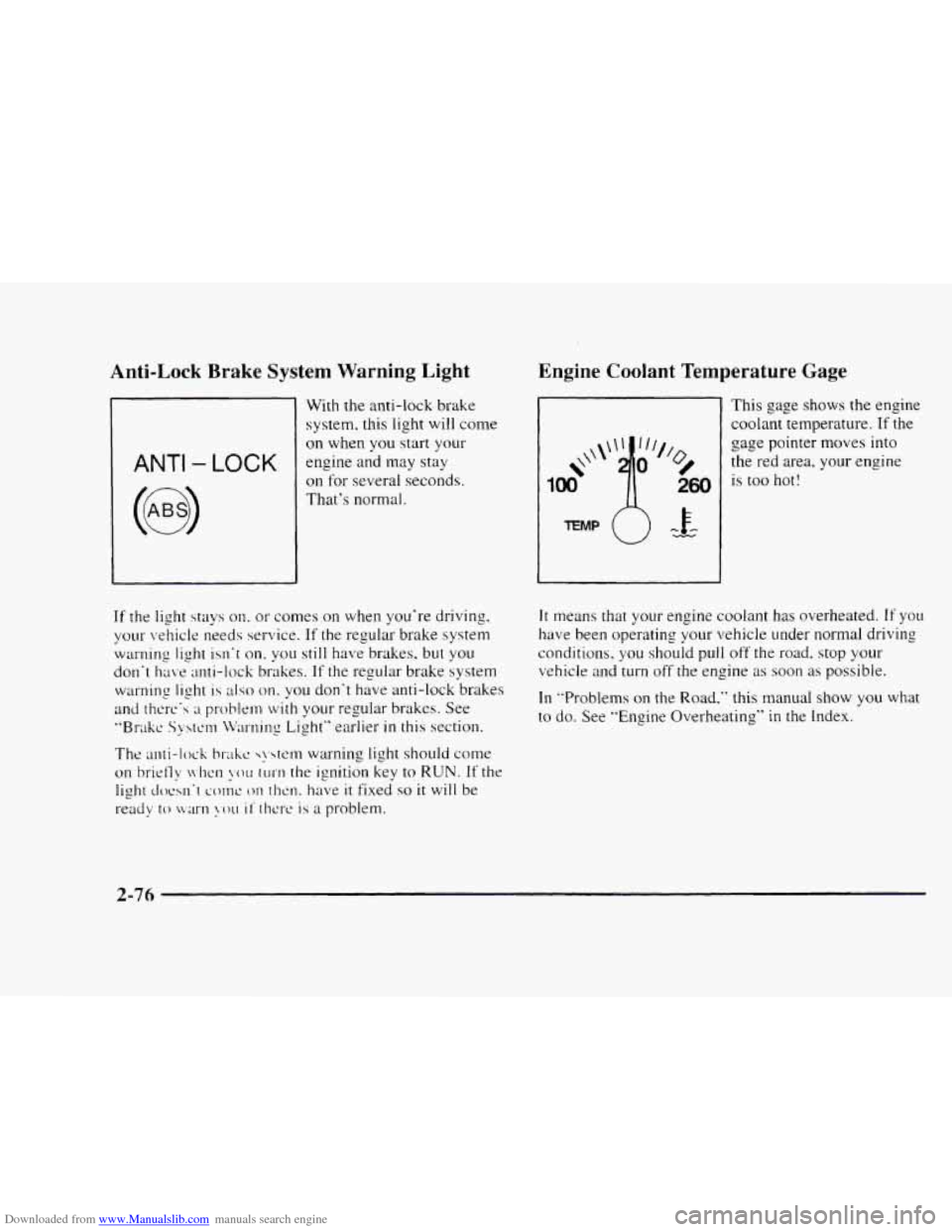
Downloaded from www.Manualslib.com manuals search engine Anti-Lock Brake System Warning Light
ANTI - LOCK
With the anti-lock brake
system, this light will come
on when you start your
engine and may stay
on for several seconds.
That's normal.
Engine Coolant Temperature Gage
This gage shows the engine
coolant temperature.
If the
gage pointer moves
into
is too hot!
the
red area, your engine 260
If the light stays on. or comes on when you're driving,
your irehick needs service.
If the regular brake system
warning
light isn't on. you still have brakes. but you
don't
have anti-lock brakes. If the regular brake system
warning light
is also on. you don't have anti-lock brakes
and there's
;I problern with your regular brakes. See
"B1-akc. Svstcm LVmling Light" earlier in this section.
The anti-lock brakc. s>.4tem warning light should come
on briet'ly n.hct1
~.ou turn the ignition key to RUN. If the
light doesn't co1nc3 011 111cn. have it fixed so it will be
ready
to w;m U)LI it' thew is a problem. lt means
that your engine coolant
have been operating your vehicle has
overheated.
If you
under normal driving
conditions. you should pull off the road.
stop your
vehicle and
turn off the engine as soon as possible.
In "Problems on the Road." this manual show you what
to
do. See "Engine Overheating" in the Index.
2-76
Page 137 of 402
Downloaded from www.Manualslib.com manuals search engine Shift Light
-w
/fls 1
You have the shift light
if you have a manual
transmission. This light
comes
on very briefly as a
bulb check when
you start
the engine. Shifting when
the indicator light is on will
help you get
the best fuel
economy. See "Shift Light"
in the Index.
1 'd 8.
Daytime Running Lamps Indicator Light
This light is on the
instrument panel. It goes on
whenever the
DRL are on,
the ignition is on,.the
headlamp switch is
off
and the parking brake is
released.
Check Gages Light
CHECK GAGES
The CHECK GAGES light
will come on briefly when
you are starting the engine.
:
.. * ,. ,. , i ..3
I I.. -_. .
If the light comes on and stays on while you are driving,
check your coolant temperature and engine oil pressure
gages to see if they are in the warning zones.
1;
.I. ..
' , .;i ,- ..
"j
.. . .
2-80
Page 168 of 402
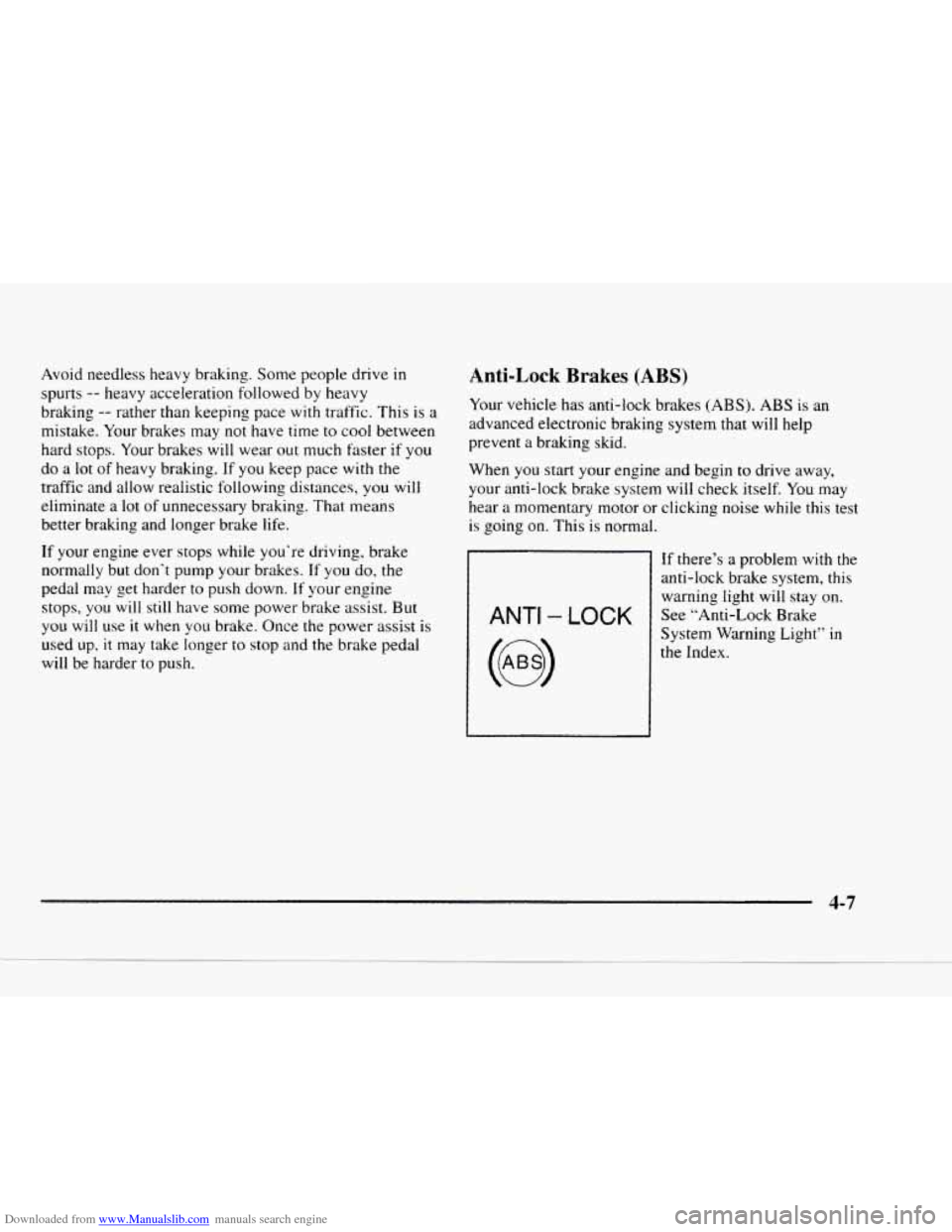
Downloaded from www.Manualslib.com manuals search engine Avoid needless heavy braking. Some people drive in
spurts
-- heavy acceleration followed by heavy
braking
-- rather than keeping pace with traffic. This is a
mistake. Your brakes may not have time to cool between
hard stops. Your brakes
will wear out much faster if you
do a lot of heavy braking. If you keep pace with the
traffic and allow realistic following distances,
you will
eliminate a
lot of unnecessary braking. That means
better braking and longer brake
life.
If your engine ever stops while you‘re driving, brake
normally but don’t
pump your brakes. If you do, the
pedal may get harder
to push down. If your engine
stops,
you will still have some power brake assist. But
you will
use it when you brake. Once the power assist is
used up, it may take longer to stop and the brake pedal
will be harder
to push.
Anti-Lock Brakes (ABS)
Your vehicle has anti-lock brakes (ABS). ABS is an
advanced electronic braking system that will help
prevent a braking skid.
When
you start your engine and begin to drive away,
your anti-lock brake system will check itself.
You may
hear a momentary motor or clicking noise while this test
is going on. This is normal.
ANTI - LOCK
If there’s a problem with the
anti-lock brake system, this
warning light will stay
on.
See “Anti-Lock Brake
System Warning Light”
in
the Index.
-. 4-7
Page 184 of 402

Downloaded from www.Manualslib.com manuals search engine Driving Downhill
When off-roading takes you downhill, you’ll want to
consider a number of things:
0 How steep is the downhill? Will I be able to maintain
vehicle control?
0 What’s the surface like? Smooth? Rough‘? Slippery‘?
Hard-pac ked dirt
‘? Gravel?
0 Are there hidden surface obstacles? Ruts’?
Logs? Boulders’?
0 What’s at the bottom of the hill? Is there a hidden
creek bank or even
a river bottom with large rocks?
If you decide you can go down a hill safely, then try to
keep your vehicle headed straight down, and use a low
gear. This
way. engine drag can help your brakes and
they
won‘t have to do all the work. Descend slowly,
keeping
y)ur
ehick under control at all times.
I A CAUTION:
1 I
Heavy braking when going aown a hill can cause
your brakes
to overheat and fade. This could
cause
loss of control and a serious accident.
Apply the brakes lightly when descending a hill
and use
a low gear to keep vehicle speed
under control.
&= Are there some things I should not do when
driving down a
hill?
A: Yes! These are important because if you ignore them
you could lose control and have a serious accident.
0 When driving downhill, avoid turns that take you
across the incline of the hill. A hill that’s not too
steep
to drive down may be too steep to drive across.
You could roll over if you don’t drive straight down.
NEUTRAL (N). or with the clutch pedal depressed
in a manual shift. This is called “free-wheeling.”
Your brakes will have
to do all the work and could
overheat and fade.
0 Never go downhill with the transmission in
4-23
Page 191 of 402
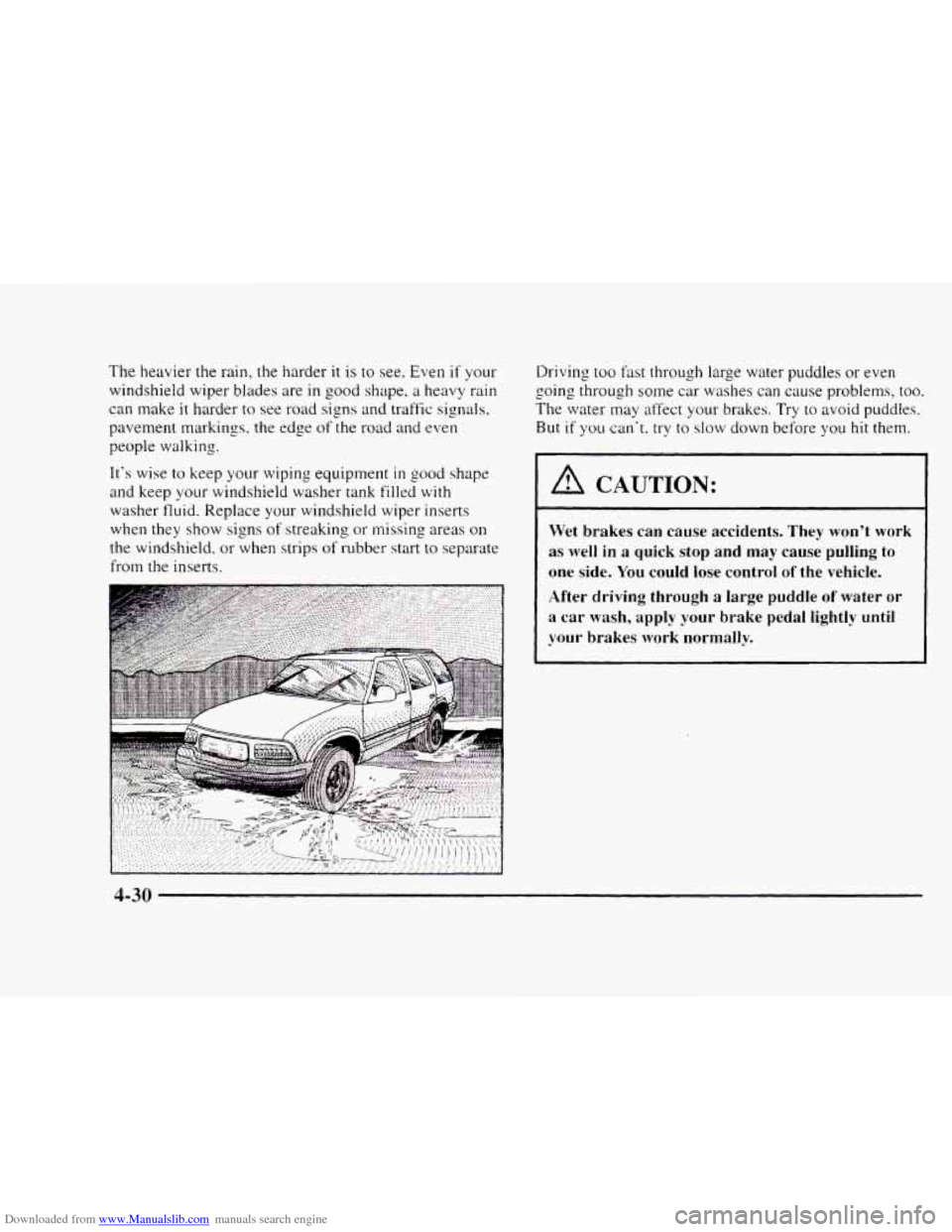
Downloaded from www.Manualslib.com manuals search engine The heavier the rain, the harder it is to see. Even if your
windshield wiper blades are
in good shape, a heavy rain
can make
it harder to see road signs and traffic sipals.
pavement markings. the edge
of the road and even
people walking.
It's wise to keep
your wiping equipment in good shape
and keep your windshield washer tank filled
with
washer fluid. Replace your windshield wiper inserts
when they show signs
of streaking or missing areas on
the windshield, or when strips of rubber start to separate
from the inserts. Driving
too
fast through large water puddles or even
going through
some car washes can cause problems, too.
The water may affect your brakes. Try to avoid puddles.
But if you can't. try to slow down before you hit them.
I A CAUTION:
Wet brakes can cause accidents. They won't work
as
well in a quick stop and may cause pulling to
one side. You could lose control
of the vehicle.
After driving through
a large puddle of water or
a car wash, apply your brake pedal lightly until
your brakes work normally.
4-30
Page 216 of 402
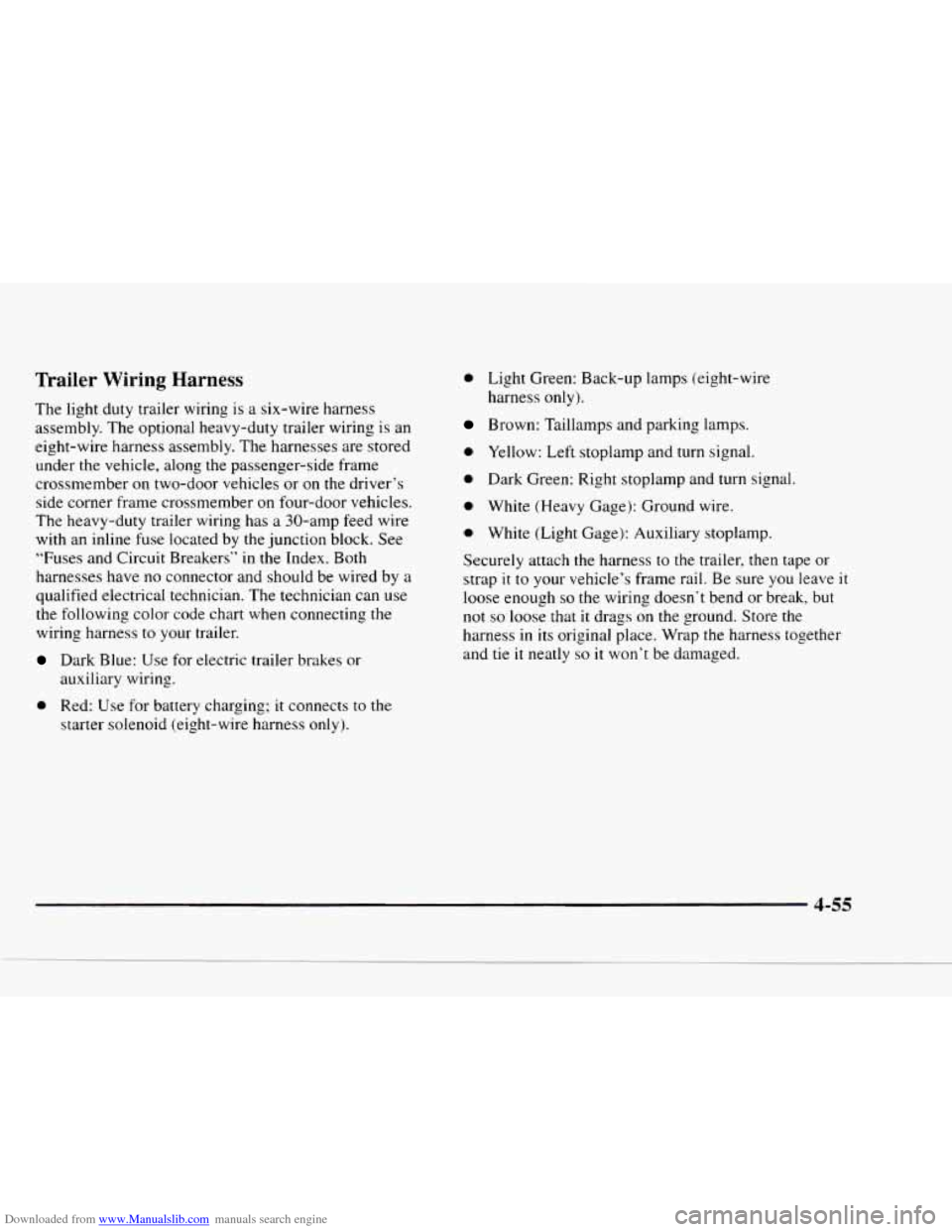
Downloaded from www.Manualslib.com manuals search engine Trailer Wiring Harness
The light duty trailer wiring is a six-wire harness
assembly. The optional heavy-duty trailer wiring is an
eight-wire harness assembly. The harnesses are stored
under the vehicle, along the passenger-side frame
crossmember on two-door vehicles or on the driver’s
side corner frame crossmember on four-door vehicles.
The heavy-duty trailer wiring has
a 30-amp feed wire
with an inline
fuse located by the junction block. See
“Fuses and Circuit Breakers”
in the Index. Both
harnesses have no connector and should be wired by a
qualified electrical technician. The technician can
use
the following color code chart when connecting the
wiring harness
to your trailer.
Dark Blue: Use for electric trailer brakes or
auxiliary wiring.
0 Red: Use for battery charging; it connects to the
starter solenoid (eight-wire harness only).
0 Light Green: Back-up lamps (eight-wire
harness only).
Brown: Taillamps and parking lamps.
0 Yellow: Left stoplamp and turn signal.
0 Dark Green: Right stoplamp and turn signal.
0 White (Heavy Gage): Ground wire.
0 White (Light Gage): Auxiliary stoplamp.
Securely attach the harness
to the trailer, then tape or
strap
it to your vehicle’s frame rail. Be sure you leave it
loose enough so the wiring doesn‘t bend or break, but
not so loose that it drags on the ground. Store the
harness in its original place. Wrap the harness together
and tie
it neatly so it won’t be damaged.
4-55